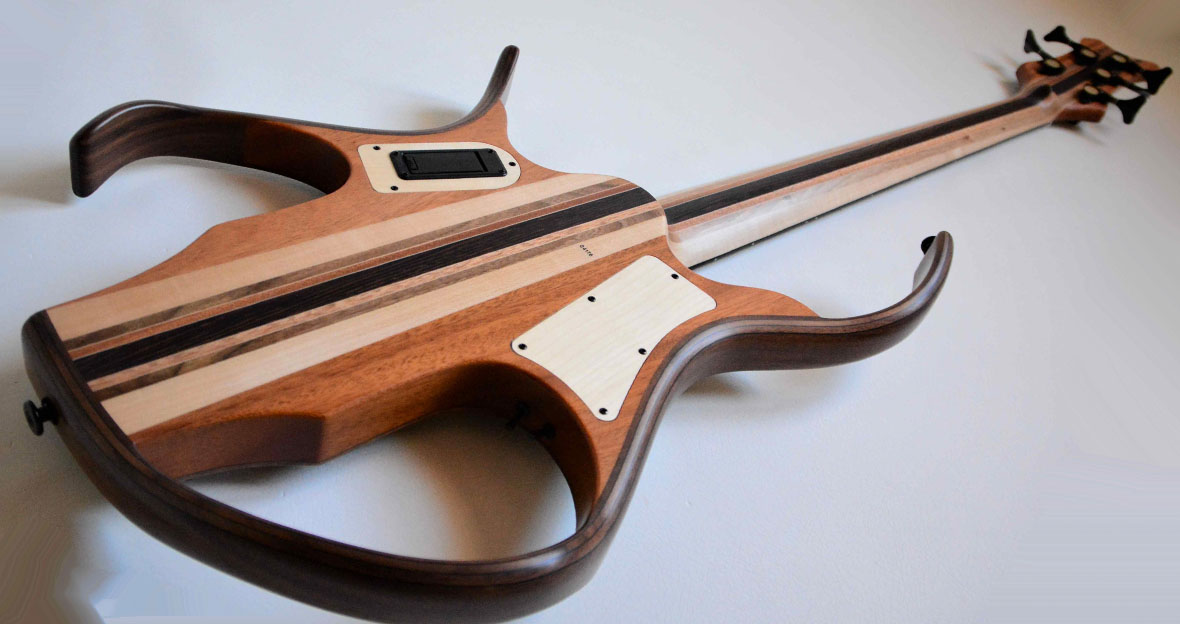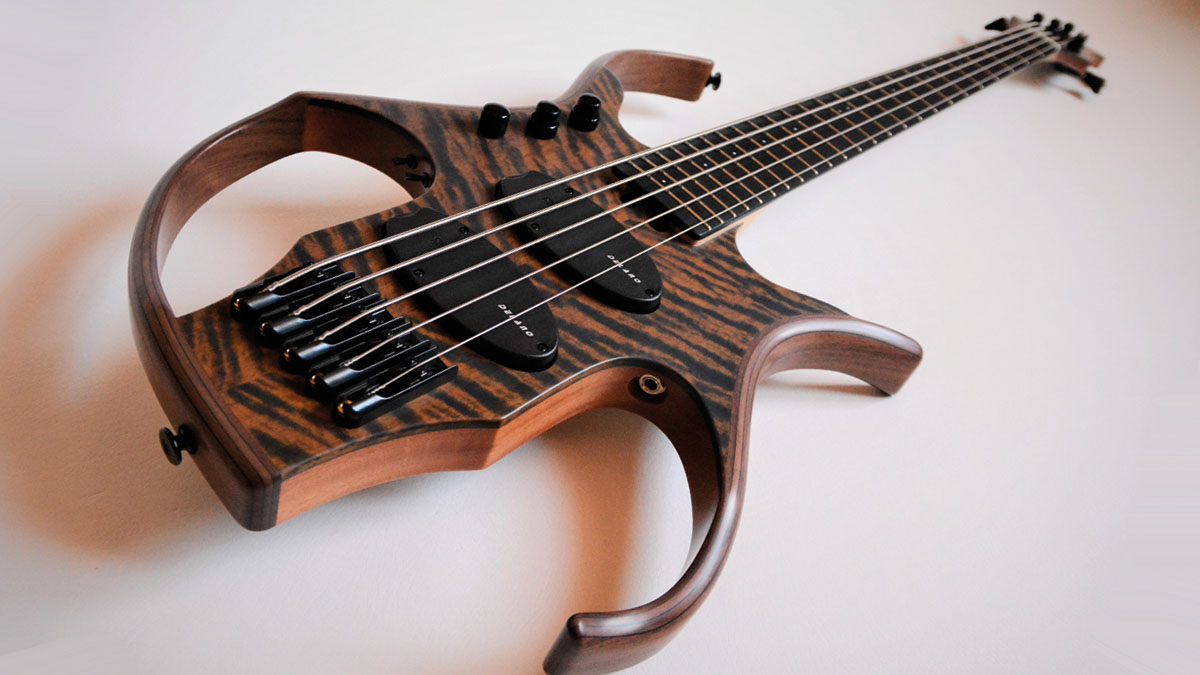Guitar World Verdict
An excellent, forward-looking instrument, the Stega Deluxe offers an unorthodox take on high-end contemporary bass design, with a huge array of excellent tones easily accessed from a super-playable chassis. Not for purists, but then you knew that already.
Pros
- +
Great design.
- +
Great tones.
- +
Plays beautifully.
Cons
- -
Some minor headstock dive when seated.
You can trust Guitar World
The Stega bass, built by luthier Paul Lairat, was originally released back in 2004, and continues to be one of the company’s most popular models.
Pairing a futuristic aesthetic with a versatile onboard preamp, the Stega Deluxe bass guitar promises to be both eye and ear-grabbing, a combination that certainly has our interest piqued.
Lairat’s growing artist list seems to bear this out, with the likes of Dave Marotta, Pepe Hernandez, Etienne Mbappé, Marc Guillermont, and fusion phenomenon Gabriel Severn all now using the company’s instruments.
Build Quality
The unusual body of the Stega has five different types of lumber: The edge splints are walnut and ebony, while the main body is mahogany with a wenge veneer. Various different kinds of lumber are available from Lairat, but our review model is topped with an eye-catching curly walnut.
The neck also comprises multiple types of lumber, formed from six strips of maple, one of wenge, two mahogany, and two walnut. This is topped with an ebony fingerboard, which is the perfect aesthetic accompaniment to the curly walnut top lumber. The large oval Delano Xtender soapbox pickups fit the bill nicely, as does the black hardware.
The design and construction of the instrument is obviously more complex than that of a conventional bass guitar, but the execution here is faultless: The build quality and finishing are superb across the board, indicative of a high-end boutique instrument.
Fretwork is excellent, as is the overall setup of the instrument. A look inside the electronics cavity reveals a well-shielded compartment and neat wiring, with a separate flip-up compartment for the 9V battery.
Unusually, the plate covering the electronics cavity appeared to be made from maple, rather than the mahogany of the body. It’s a very minor gripe, but I felt this looked out of place, and would have preferred to see a matching cover. But who looks at the back of an instrument?
Soloing the neck pickup yields a powerful, well-rounded tone that had plenty of thump, while the bridge pickup offers up some serious bite
You’ll likely have noticed that in terms of the control set, the Stega Deluxe is somewhat unorthodox. In the absence of a lower portion of the body, the preamp and controls are instead mounted on the top bout of the instrument, with two additional toggle switches tucked away in the upper cavity.
The first two of the three controls are stacked: Master volume/mid and treble/bass boost and cut, respectively. The third control is the pickup blend. The two toggle switches are an active/passive switch and a split pickup switch.

Sounds And Playability
The onboard Glockenklang preamp caters well to the needs of the modern bassist: Soloing the neck pickup yields a powerful, well-rounded tone that had plenty of thump, while the bridge pickup offers up some serious bite.
Despite its unusual ergonomics, this is an incredibly playable instrument, smooth and easy to get around, as well as being inspiring to work with
Soloing either pickup results in tones that are fairly extreme in terms of the aforementioned thump and bite, and the best results – as with most active instruments – come from finding that sweet spot in between that works in whatever context you’re playing in. Fine-tuning with the treble/bass controls adds further flexibility to the palette, of course.
In passive mode, the Stega remains incredibly effective: One of the benefits of the preamp is that if the EQ controls are centered in active mode, there is no noticeable drop in volume when switching between active and passive. In terms of playability, the Stega responds well to whatever I throw at it.
Despite its unusual ergonomics, this is an incredibly playable instrument, smooth and easy to get around, as well as being inspiring to work with.
The placement of the controls is no issue with regard to actually playing the instrument, although it’s worth noting that the absence of a considerable amount of body mass does affect the balance to a degree – I found that the instrument exhibits some headstock dive when played seated. Fortunately, despite the absence of a certain amount of lumber, sustain is excellent.
Conclusion
With so many of today’s bass guitars built on just a few basic tried-and-tested templates, it’s refreshing to see a builder looking for new ways to approach the design. All of Paul Lairat’s instruments part ways with the conventional to one degree or another, and I for one am glad to see it.
The appearance of the Stega certainly divided opinion among those who saw it, but feelings were overwhelmingly positive and certainly no-one could forget it. Retailing at such a high price, the Stega Deluxe occupies a challenging sector of the market, particularly during these uncertain times.
That said, it’s an instrument that would work well for those looking for something a bit special: It’s versatile, comfortable and offers a wide tonal palette. It’s perhaps not one for the low-slung rock brigade, but who knows? If you’re looking for something a little different, we’d certainly recommend a test drive.
Specs
- PRICE: $3990
- MADE IN: France
- BODY: Walnut and ebony splints, mahogany and wenge body, curly walnut top
- NECK: Maple, wenge, mahogany, walnut
- FRETS: 24
- PICKUPS: Delano Xtender
- ELECTRONICS: Glockenklang
- CONTROLS: Stacked master volume/mids, stacked treble/bass, pickup blend, active/passive switch, split pickup switch
- HARDWARE: PL by Gotoh, ABM bridge
- WEIGHT: 9 lbs
- LEFT-HANDED OPTION AVAILABLE: Yes
- CASE/GIGBAG INCLUDED: Gigbag
- CONTACT: Lairat
“Affordable versions of the three best basses I've ever held in my hands”: Sterling by Music Man completes its trilogy of Joe Dart signature models with a trio of made-to-order basses that cost less than $500
“The ace up the sleeve of bass players around the globe since 1978”: Tobias instruments were trailblazers in the bass world. Now they’re back as part of the Gibson family











